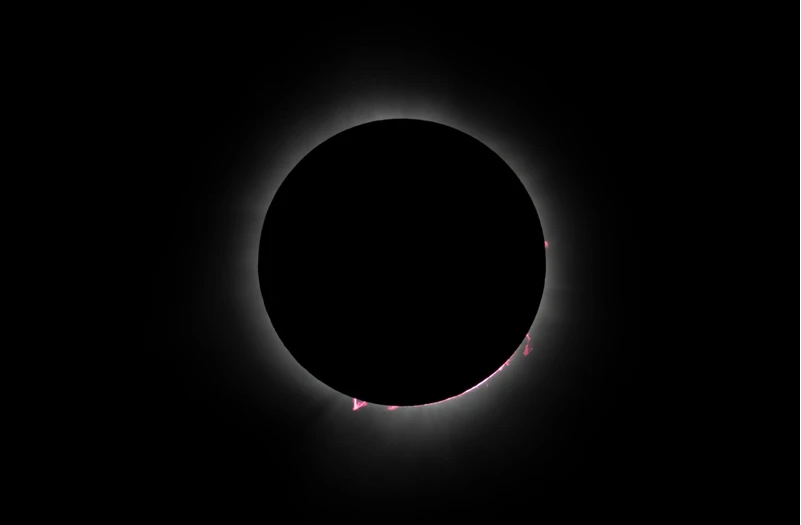
North America: The awe and beauty of the solar eclipse
About 2 000 people flocked to Ingram in Texas, a small city in the “path of totality” where the solar eclipse could be observed in its entirety.

The day died and was reborn a few minutes later on Monday in the southern United States. There were hugs, tears and gasping as people watched the moon fully eclipse the sun and briefly plunge the world into darkness.
About 2 000 people flocked to Ingram in the southern US state of Texas, a small city in the “path of totality” where the solar eclipse could be observed in its entirety.
Spread on mattresses on the grass, sipping wine comfortably from folding chairs or peering into large telescopes, the viewers, their eyes covered by special protective glasses, celebrated each time the gray clouds parted, letting them enjoy the wonder.
“Three, two, one!” a man shouted.
And there was the Moon, a black orb completely covering the Sun, with only tiny slivers of light escaping from the edges. It was 13:32 local time.
Mary Elizabeth Fernandez, a 43-year-old librarian, said she came to Ingram because she wanted to observe the eclipse from Stonehenge II, a replica of the prehistoric stone monument the town is famous for.
“It was just so moving and spectacular. I tried to get pictures with my camera,” said Fernandez, who was accompanied by her boyfriend.
“I cried a little bit because it’s just so beautiful. And I’m just really glad that I was able to be a part of this with everybody here. It was really wonderful.”
A few meters away, a large family shared drinks and snacks.
Mary McClintock, a 77-year-old retired teacher, said her relatives converged on Ingram from three different states: California, Florida and Illinois.
“We were so happy to see the different stages that we got to see even though it was cloudy,” McClintock told AFP.
“And we wanted to be together. And so we thought even if it’s cloudy, we’re happy to be here as a family and we’re going to enjoy every minute we have.”
LIGHT CONQUERS DARKNESS
Meanwhile, Jeni Lyn Hunter, 60, and her 57-year-old husband Charles Guillory gazed skyward, with large sorcerer’s hats balanced precariously on their heads.
“It means a lot to me because I have stage 4 cancer. But I’m not giving up, this is a rebirth of the Sun of life,” Hunter said.
“It’s the cycle between life and death and life again, and I’m going to live for him, and for me and because I don’t want to go anywhere.”
Guillory was by his wife’s side. “My hopes are for her to stay with me,” he said.
Further away, under the replicas of moai statues – the enormous stone human figures on Easter Island – Gary Christensen and his wife Elizabeth took photos as they celebrated her husband’s 62nd birthday.
“For a year and a half, this is the only present we’ve given each other every Christmas, every Mother’s Day, Father’s Day, birthday, ‘Oh, we’re going to the eclipse’.”
And then there was Robb Guzman, 31, wearing a mask of a green extraterrestrial with large elongated eyes.
“I thought the aliens were going to come this time,” he said. “But it was still fantastic.”
SPIRITUAL MEANING
More than 1 400 miles (2 250km) away at Niagara Falls, Canada, crowds of people observed the eclipse under the cries of gulls and the roar of the famous waterfall.
Debi Flamand, a member of Canada’s Manawan First Nations community, said witnessing a total solar eclipse “is very spiritual for us, because the sun for us is the grandfather and the moon is our grandmother.”
For several minutes, the skies above the waterfalls and Toronto’s distant silhouette grew dark as spectators shouted in excitement.
Madison, a young woman who made the trip from Boston, could not believe her eyes.
“Those things that feel so impossible in this vast universe and it is happening just here,” she said.
Meanwhile, the eclipse was not visible in South Africa.
The next visible eclipse in South Africa is the Partial Lunar Eclipse which is scheduled to take place on 18 September 2024.
Meanwhile, the next Total Solar Eclipse which will be visible from South Africa is scheduled for 25 November 2030.
By Garrin Lambley © Agence France-Presse